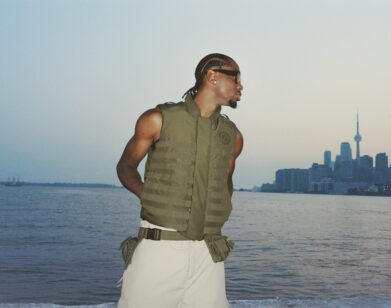Designers Are Solid in Stockholm
On Monday, Swedish actress and local style icon Noomi Rapace cut the inaugural ribbon announcing the start of the 13th Mercedes-Benz Fashion Week in Stockholm. A relative unknown until her breakout role in Girl with the Dragon Tattoo (2009), Rapace could be seen as a symbol for how the Swedes hope to position themselves on the global stage of fashion: emerging from the unfamiliar to be seen as a major contender amidst a growing number of fashion weeks around the world. Because of Rapace (and, though she’s not Swedish, Rooney Mara), brands like H&M, Acne, Filippa K and J. Lindeberg, the country is synonymous with style. The country’s minister of trade announced polemically this week that Sweden is “the most creative country in the world,” as measured by what’s called “The Global Creativity Index by the Martin Prosperity Institute.”
This is all good news for the nearly 30 Swedish brands that premiered their Autumn/Winter 2012 collections during a whirlwind 72-hour fashion week that commenced last night.
Blacks, browns, grays, and creams dominated the runways this week. But the Nordic country’s long, brutal winters mean that many designers account for functionality first, while Sweden’s long history of embracing a spirit of collectivism over individuality is also reflected in their fashion. The norm is not to stand out, but rather to blend in. This philosophy has led to decades of minimal, sophisticated, and purpose-driven designs. But what Stockholm’s designers may lack in risk-taking, they make up for in sleek, wearable and timeless pieces, which we saw no shortage of this season.
A highlight was the always-elegant Carin Rodebjer, who celebrated “manhood” by presenting her vision of womenswear, inspired by stylish men like David Hockney and Jean Cocteau. Miniskirts, jackets, and sweaters in deep gold, black, and “night blue” navy came in lush, crushed velvet. A flowing, floor-length frock, with buttons that followed a slit suggestively high up the leg, was vibrant in “Wild Strawberry Red.” A long, wool coat in plaid, buttoned down the back with a wraparound enclosure where a fringe of black rested neatly, was among the collection’s finest.
A sharp contrast to Rodebjer’s unassuming feminity was V Ave Shoe Repair, a Stockholm favorite for their smart streetwear for men and women. Military cuts, rubber Mad Max-like accoutrements, and a dark, industrial aesthetic could have defied the designer’s intended takeaway: “We hope that we can give positive energy to the viewer and add strength and optimism to the world,” explained designers Astrid Olsson and Lee Cotter. Moments of white silk trousers and crisp button-downs brought this brightness to the surface and punctuated a black heavy collection dubbed “Man vs. Machine.”
Carin Wester, another veteran to the Swedish fashion scene known for her androgynous shapes and artful pieces, presented her eponymous woman’s collection as well as “Wester” for men. For females, we saw boxy, structural jackets and sweaters in thick mohair, teamed with slim trousers and white dresses in soft cotton crepe. The lighter the looks became, ranging from deep grays to rich creams, the more interesting the collection. Models navigated around a grid sculpture that paralleled the architectural elements found within the clothes. “Our fashion show this season had a different setting then what we have done during the previous seasons. The models had to walk a more complex choreography that needed to be timed with the music and the lighting in a very precise way which was a bit challenging but it worked out great in the end,” Wester elaborated.
Minimarket produced the most theatrical runway of the week. With her Mediterranean features and physical drama, Spanish actress Rossy de Palma, one of Pedro Almodóvar’s more complex muses, introduced Minimarket’s feminine noir collection. In between sheer beaded sheaths and leggings, cropped sequined waistcoats topped off with big hair and exaggerated hats, audience members were treated to a variety of magic tricks. Several flowing floral wraps took the stage before the show’s final, sword-swallowing climax.
House of Dagmar, named for the grandmother of the three sisters behind the line, delighted a crowd that included Spike Jonze, with form-fitting backless dresses and plunging necklines; a filmy cheetah pantsuit; and chunky alpaca wool sweaters with an interesting provenance: “We wanted to do a ‘real-fake fur’ out of this very heavy yarn, but it turned out it was difficult to knit, so the supplier in Lithuania made it in her aunt’s rug factory. It’s a bit funny but it works well and it is super warm,” said Karin Söderlind, the eldest of the three sisters. The skinny, dip-dyed, stone wash jeans used as a staple in many of their Winter looks were Söderlind’s favorite article and she added, “The color fading makes them to be more than just a pair of jeans. Lots of attitude in them.”
Even more attitude came by way of Stockholm’s revered Beckmans College of Design. Pioneering a new era of big, bold fashion in bright colors and alternative fabrics and cuts, the 12-student show was refreshingly complex. Motivated by the Bosnian national costumes from her war torn homeland, Lamija Suljevic’s headdresses of gold coins and fluorescent flowers nodded to Frida Kahlo, and were paired with embroidered shells; while Aline Brane’s metallic patch worked skirts and outerwear mimicked ethnic prints with a range of texture. The energy and experimentation taking place at Beckmans could be a window into the future of Swedish fashion with a promise to move beyond the limits functional style, ushering in a new era of style to a city that has already captured the world’s attention.







